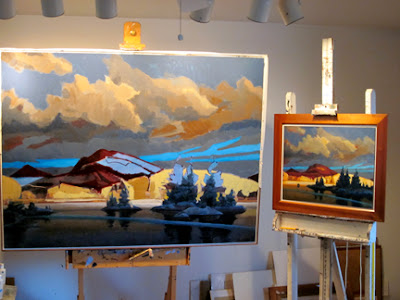Fighting the Headwinds
When you make a painting it's a little like sledding uphill or pushing back against a strong headwind. As difficult as this is, a lot of painters have succeeded. How? One way I'm convinced is their experimenting with the same basic idea. They give it different forms until they finally get it right. For painters, this means working on several different versions, often at radically different sizes.
Above is my studio this morning. On the left easel is a 45 x 60" oil I've been working on again after a long time. At the right is a new oil study, North Passage, oil on panel, 18 x 24" that I finished last week.
The new small painting is giving me great ideas on how to resolve the big guy at the left.
The large oil has a real history- it's had several different stages and I've had a continuing urge to keep fiddling with it. Sometimes I just plunge ahead and work directly on the large canvas. Other times though it just feels better to work out the in-progress painting on a smaller scale. That's what I'm doing here.
When you hop from one surface to another to try a different version of a composition, it feels different. The size changes, the texture of the surface is different, and the lack of a prevous history all conspire to push you into a different head set. Artist's use the term studies to label paintings (or drawings) they do to help them find their way on yet to be completed major pieces. There's a long history of doing studies- most of what we now call "master drawings" were studies for oil paintings.
Here's a photo I took inside Edward Hopper's Truro, Massachusetts studio in September 2010. We're standing in his painting room looking to the right out to Cape Cod Bay and to the left to his bedroom.
Below is a drawing Hopper made while considering this corner of his world. As you can see, he was
thinking about how the place would look if one was sitting down.
But Hopper used the fresh start that making a study drawing afforded him to free up his imagination in other ways. For example he moves the hinges holding the door to the opposite side of the doorframe. And he imagines a shaft of sunlight diagonally cutting across the empty white wall (that in reality never receives direct sun as it faces due north). Most radically of all, he bulldozes away all the ground so as you step outside the door you plunge into the sea.
I think Hopper's painting below, Rooms by the Sea, now in Yale's art musuem, couldn't have happened had Hopper not experimented with making changes from the actual reality of his studio. The study
drawing was small and rapidly executed. Doing it quick and causual like that gave Hopper the chance to nail down a new idea that wasn't yet fully formed in his imagination. Making big changes to his idea depended on playful experimentation. Artists have to have some slack in their reins to let creative horses find the way.

Below is my oil from 1993, Edward Hopper's Rooms by the Sea, oil on canvas, 36 x 54". It's a more litereal view of the Hopper studio I painted from life during one of my many residencies there. My goal then was to be faithful to the facts of the place. It's a fun comparison.






